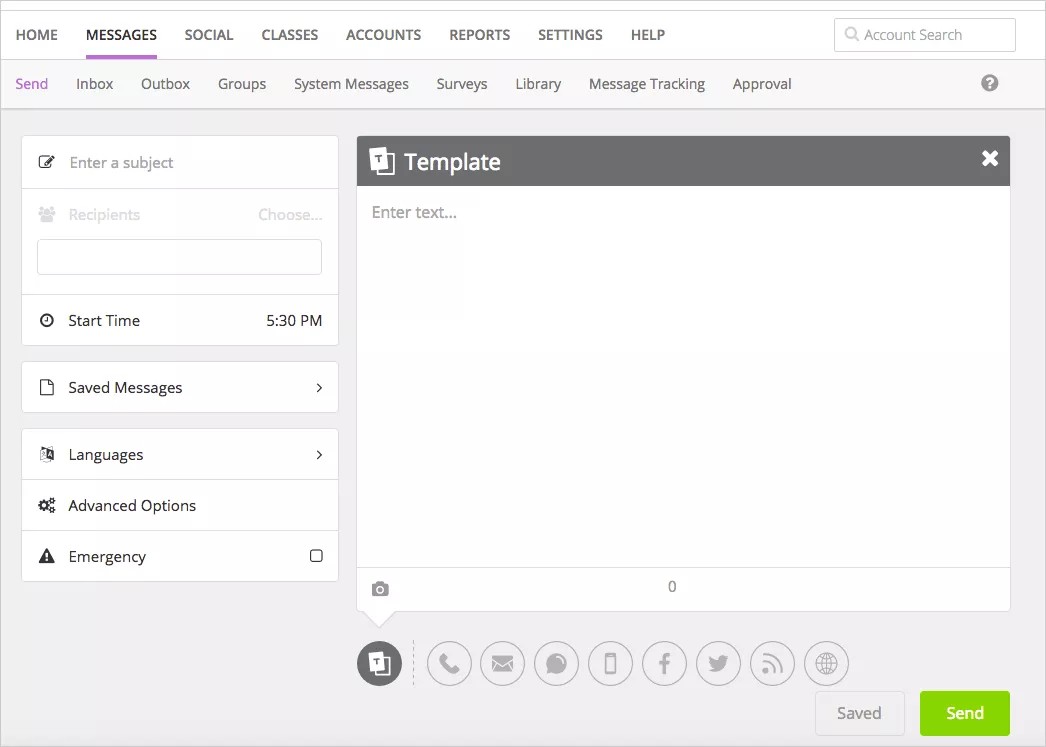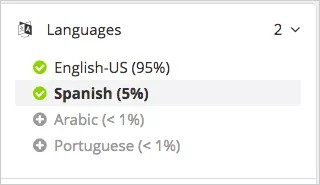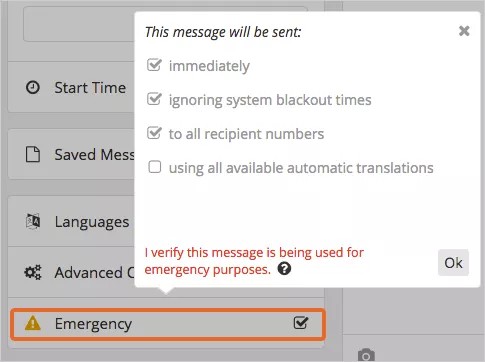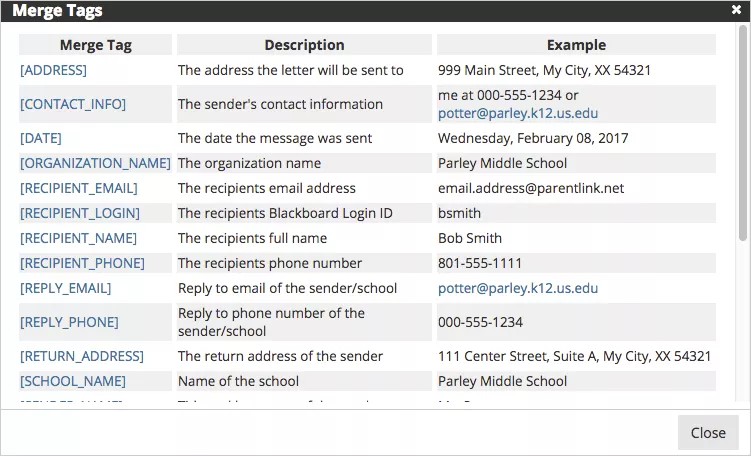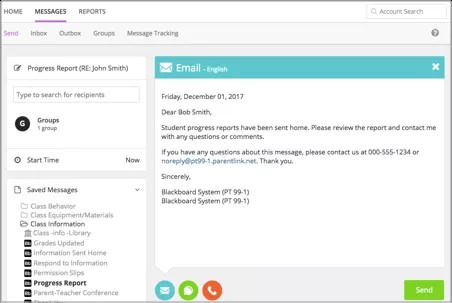Create once - publish everywhere!
You can create and customize messages to send to recipients by phone, email, text, app, and social media. Depending on who you are trying to reach and what your message is, you can select different types of delivery methods (default delivery options can also be pre-set).
Watch the Send Message Interface https://player.vimeo.com/video/123036930 video for a tutorial of sending messages.
Create a message
Senders cannot cancel a message during its delivery, a message can only be canceled 5 minutes before the delivery is set to begin.
- From the Blackboard Communications HQ interface menu, select Messages > Send.
- Type the Subject for the topic of the message.
- Add Recipients, use a Saved Message to resend common messages, change the start time, or adjust many other options.
- Select one or more delivery methods from the main send message page to send to the recipients:
- Template option - Create a template message to be used on all of the delivery types and modified later in each one to customize them. Type the body of the message here. You can also add images for the template option. Not all messages types will post images.
- Phone messages - If you created a template message, the content will be added here for phone calls. You can update the text and select how to make the recording - Call me to record, Call in to record, Upload audio file, Text to speech, or Use microphone. To remove the phone call option, close out the tab from the upper right hand corner.
- Emails - If you created a template message, the content will be added here for emails. You can update the text and add any images. To remove the email option, close out the tab from the upper right hand corner.
- Text/SMS - If you created a template message, the content will be added here for text/SMS messages, but you may need to edit the content to be less than 160 characters. To remove the text/SMS option, close out the tab from the upper right hand corner.
- Mobile App Notifications - For districts and schools that subscribe to Blackboard Mobile Communication app, the content will be added here for the app notifications. You can update the text and add any images. You can also mark the notification to appear only to known recipients and not to the general public of your mobile app. To remove the app notification option, close out the tab from the upper right hand corner.
- Facebook - For districts and schools that subscribe to Blackboard Mass Notifications, Blackboard Mobile Communication app, or Blackboard Social Media Manager, the content will be added here for Facebook messages, but you may need to edit the content to be less than 160 characters. You can update the text and add any images. To remove the Facebook option, close out the tab from the upper right hand corner.
- Twitter - For districts and schools that subscribe to Blackboard Mass Notifications, Blackboard Mobile Communication app, or Blackboard Social Media Manager, the content will be added here for text/SMS messages, but you may need to edit the content to be less than 140 characters. You can update the text and add an image. To remove the Twitter option, close out the tab from the upper right hand corner.
- RSS - For districts and schools that send messages to a third party website, the content will be added here for RSS feeds.
- District/School Websites - For districts and schools that subscribe to Blackboard Web Community Manager and have implemented the Universal Navigation bar, the content will be added here for your district or school websites. You can update the text and add any images. To remove the website option, close out the tab from the upper right hand corner.
- Alerts - For districts and schools that subscribe to Blackboard Web Community Manager and have implemented the Universal Navigation bar, the content will be added here for your district or school website on-screen alerts. You can update the text and select which sites will display the on-screen pop-up alert message. To remove the alert option, close out the tab from the upper right hand corner.
- Include language translations by selecting Add Language, and select each language needed.
You can remove any language with the Delete icon.
Amheric language will not include translation or text-to-speech capabilities. Some Android devices and iOS do NOT support Amheric, and the message may not look correct on those devices. However, it is expected that those users requiring Amheric language will use phones that support the display.
- Set the message as an Emergency if needing to send out immediately.
You can set the message to be sent immediately with the proper language translations.
- Select Send when ready to send the message.
Merge tags with recorded messages
You can use merge tags for recorded phone messages. The tag will record the information available in the database for the specific information.
For example, if you want parents to confirm that their specific child is absent with a phone message, you can record the message, insert a merge tag for the name of the student, and the student's name will be inserted into the generalized recording. Then the message will be sent to all parents of absentee students with the information for their own child.
Merge tags help you to send personalized messages with only one recording.
- In the Advanced Options section, select Use merge tags with recorded audio.
- From the Phone area of the Send Message interface, select Call me to record or Call in to record.
- When typing your script, select your merge tags through the Merge Tags feature. To avoid errors, do NOT copy and paste merge tags into the text.
- Read the script and when you see a merge tag, press the Star (*) button on your phone. Wait for the beep to continue reading your script.
- Press Pound (#) when finished recording, and press 1 to save the message.
Send a saved message
There are several pre-written, standard messages you can use.
- System created: Written and recorded in four supported languages: English, Spanish, Portuguese, and Haitian-Creole. Can't be edited, copied, or deleted. Identified by the Blackboard logo.
- Admin created: Created by your district administrator. Can be copied only. Identified by an image of a building.
- User created: Written and recorded by a user. Can be edited, copied, and deleted. Identified by an image of a person.
Create your own or use system and admin created ones to make common communications easier.
- Select any default or saved messages from the folders in the Saved Messages section. Open each folder to see what default and saved messages are in them.
- If you have permission, update the message or select other delivery methods - Phone, Email, Text/SMS, App Notifications, RSS, Facebook, Twitter, District/School Websites.
- Add Recipients, change the start time, or adjust many other options by using the menu to the left of the message area.
- Include language translations by selecting the Languages.
- Set the message as an Emergency if you need to send it immediately.
- Select Send when ready to send the message.
Search for recipients
Users are able to select recipients by groups, schools, grades, even individually. There are various ways to select recipients.
Use advanced message options
You can adjust how messages are sent — adjust the send time, recipient numbers, and change who is allowed to send this message at another time.
- Select Advanced Options.
- Select the specific district or school from the Sending Organization list.
- Adjust the Delivery Schedule by setting a start date/time, and an end date/time.
- To schedule messages to be sent multiple times, select the Add (+) icon to set multiple dates and times. Use this feature to send reminders to recipients multiple times for an upcoming event.
- Select or clear the remaining options:
- To send a message during blackout times, select Send messages during blackout times.
- To send a message to all numbers available for every user, select Deliver to ALL recipient delivery addresses.
Select Deliver to ALL recipient delivery addresses only during emergencies.
- To send to the parents of selected students, select Deliver to parents of students.
This doesn't send the message to the students, just to the parents of the selected students. If you want to send the message to both parents and students, you have to select both as recipients.
- If you want the header and footer information included in an audio message, clear the Do not play header/footer prompts during outbound calling option. This option is usually checked so that the header and footer information is not included.
- To save this message as public, select Allow other users to also send this message (public).
- If you want recipients respond by pressing 2 from their phones, select Allow message recipients to respond to this message via voice recording.
- If using merge codes for phone messages, select Use merge tags with recorded audio.
- Select Save when finished.
접근 가능한 메시지 생성
전 세계 수십억 명의 사람들이 정신적 또는 신체적 장애를 갖고 있다는 사실을 알고 계십니까? 또한 북아메리카의 모든 학생 중 12.9%가 몇 가지 형태의 장애를 가지고 있다는 사실은 알고 계십니까? 모든 학생과 커뮤니티 학습자가 커뮤니케이션을 이해하고 있는지 확인하는 것이 중요합니다.
모든 커뮤니케이션에 대한 접근성 모범 사례
이메일 또는 Facebook에서는 이러한 접근성 모범 사례를 사용하여 메시지를 접근 가능하게 만드는 것이 쉬우므로 문제가 없습니다.
- 분명하게 씁니다. 문장을 짧게 유지합니다. 가능한 경우 1~2음절의 단어 또는 단어 조합을 사용하십시오. 축약형을 사용합니다. Hemmingway Editor와 같은 도구를 사용하면 텍스트의 판독성을 측정할 수 있습니다.
- 중요성을 나타내기 위해 글꼴 스타일 또는 색상만 사용하지 마십시오. 강한 시각 신호를 제공해야 할 경우 접근 가능한 대안을 사용해야 합니다. 중요한 경우에는 문장 끝에 느낌표를 사용합니다. 화면 리더의 오디오가 재생될 때 느낌표와 물음표 부분에는 억양이 들어갑니다. 즉, '물음표'라고 읽는 대신 질문을 크게 읽으면서 의문문의 어조를 드러냅니다.
- 이미지에 대체 텍스트를 포함합니다. 보조 도구는 이미지인지 여부를 이미 알고 있으므로 "~의 이미지"라고 말할 필요가 없습니다. 간결하고 명확하며 설명이 포함된 텍스트를 사용하십시오. 모든 이미지에 대해 "관련 텍스트를 보여주는 이미지"와 같은 동일한 대체 텍스트를 사용하지 마십시오. 의미가 없으며 혼란만 줍니다.
- 대체 텍스트를 추가할 수 없는 경우 이미지 캡션을 추가합니다. 대체 텍스트를 이미지에 추가할 수 없는 경우, 텍스트가 이미지를 활용하지 않고도 모든 정보를 전달하는지 확인하십시오.
- 링크가 내용을 설명하도록 합니다. 모든 링크는 사용자가 링크를 클릭할 경우 찾을 수 있다고 기대하는 대상을 설명해야 합니다. "여기를 클릭" 또는 "항목 더 보기" 등의 일반 어구를 사용하지 않도록 합니다. 웹 주소 또는 URL은 정보를 제공하는 것으로 간주되지 않으며 사용해서는 안 됩니다. 그러므로 내용을 설명하는 텍스트를 사용하십시오.
- 첨부 파일을 접근 가능하게 만듭니다. 동일한 모범 사례에 따라 첨부 파일을 접근 가능하게 만듭니다. 자세한 내용을 알아보려면 Blackboard에서의 접근성을 참조하십시오.
- 비디오에 선택 캡션 또는 자막을 포함합니다. 비디오에 선택 캡션이 포함되지 않은 경우 자막에 링크를 설정합니다.
- 메시지 소리가 제대로 들리는지 들어봅니다. 대부분의 장치에서 사용 가능한 텍스트-음성 전환 도구를 사용하여 메시지를 보내기 전에 듣습니다.
소셜 미디어의 접근성
소셜 미디어에 접근할 수 없는 경우도 있습니다. 화면 리더 사용자는 탐색하는 데 어려움을 겪으며 컨텐츠에 머리글, 이미지에 대한 대체 텍스트 또는 비디오 캡션이 사용되지 않을 수 있습니다. 이 경우에도 소셜 미디어를 사용할 수 있습니다. 즉, 청중이 있는 장소에서는 소셜 미디어를 사용할 수 있습니다. 가능한 한 모든 청중에게 다가갈 수 있도록 컨텐츠를 접근 가능하게 만듭니다.
Facebook 또는 Twitter 사용 시 모든 컨텐츠에 대한 접근성 모범 사례와 이러한 팁을 따릅니다.
- 게시하는 모든 사진과 이미지에 텍스트 대안을 제공합니다.
- 비디오를 게시할 경우 자막에 링크를 설정합니다.
- 트윗에 있는 내용을 청중에게 말합니다. 트윗에 사진, 비디오 또는 오디오가 있는 경우, 트윗 시작 부분에 다음 접두사를 사용합니다.
- 사진: [PIC]
- 비디오: [VIDEO]
- 오디오: [AUDIO]
- 트윗의 끝부분에 해시태그와 멘션을 둡니다.
- 해시태그에 카멜 대/소문자를 사용합니다. 해시태그에서 각 단어의 첫 번째 글자를 대문자로 표시합니다. 예를 들어, #BlackboardAccessibility와 같이 표시합니다.
- 화면 리더에서 읽을 때 이상하게 들리는 텍스트 통상어는 사용하지 않습니다.
